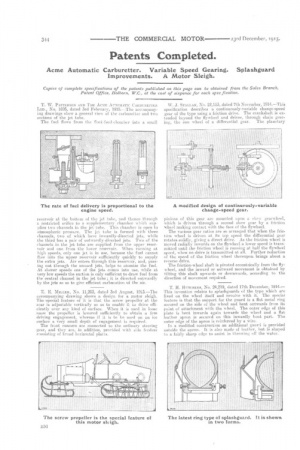Patents Completed.
Page 20

If you've noticed an error in this article please click here to report it so we can fix it.
Acme Automatic Carburetter. Variable Speed Gearing. Splashguard Improvements. A Motor Sleigh.
Copies of complete specifications of the patents publi.shed on this pare can be obtained from the Sales Branch, Patent Office, Holborn, W.C., at the cost of sixpence for each spec fication,
T. W. PATTERSON AND TBE ACME AT:TOMATTC CARBURETTER LID., No. 1695, dated 3rd February, 1915.---The accompanying drawings show a general view of the carburetter and two sections of the jet tube.
The fuel flows from the flon Heed-chamber into a small
reservoir at the bottom of the jet tube, and thence through a restricted orifice to a supplementary chamber which supplies two channels in the jet tube. This chamber is open to atmospheric .presscre. The jot tube is formed with three channels, two of which have inwardly-directed jets, while the third has a pair of outwardly-directed jets. Two of the channels in the jet tube are supplied from the upper reservoir and one from the lower reservoir. When running at liygfi speeds, only one jet is in use, because the fuel cannot flow into the upper reservoir sufficiently quickly to supply the extra jets. Air enters through this reservoir, and, passing out through the unused jets, helps to atomize the fuel. At slower Teeds one of the jets comes into use, while at very low speeds the suction is only suffici.mt to draw fuel from the central channel in the jet tube ; it is directed outwardly by the jets so as to give efficient carburation of the air.
E. E. MILLER, No. 11,203, dated 3rd August, 1913.—The accompanying drawing shows a de.siDi for a motor sleigh. Tho \special feature of it is that the screw propeller at the rear is adjustable vertically so as to enable: it to drive efficiently over any kind of surface. When it is used in loose snow the propeller is lowered sufficiently to obtain a firm driving engagement, whereas if it is to be used on an ice surface a very small depth of engagement is required.
The front runners are connected to the. ordinary steering gear, and they are, in addition, provided with side fenders consisting of bread horizontal plates. W. J. STALLAY, No. 22,153, dated 7th November, 1914.—This specification describes a continuously-variable change-speed gear of the type using a friction drive. The crankshaft is extended beyond the flywheel and drives, through than; gear
ing, the sun wheel of a differential gear-. The planetary
pinions of this gear are mounted upon a skew gearwheel, which is driven through a second skew gear by a friction vheel making contact with the face of the flywheel.
The various gear ratios are so arranged that when the friction wheel is driven at its top speed the differential gear rotates solidly, giving a direct drive. As the friction wheel is moved radially inwards on the flywheel a lower speed is transmitted until the friction wheel is running at half the flywheel speed, when no drive is transmitted at all. Further reduction of the speed of the friction wheel thereupon brings about a reverse drive.
The friction-wheel shaft is pivoted eccentrically from the flywheel, and the inward or outward movement is obtained by tilting this shaft upwards or downwards, according to the direction of movement required.
T. H. IdurcifiNs, No. 24,219, dated 17th December, 1914.— This invention relates to splashguards of the typo which are fixed on the wheel itself and revolve with it. The special feature is that the support for the guard is a flat metal ring secured on the side of the wheel and bent outwards from its pant of attachment with the wheel. The outer edge of this plate is bent inwards again towards the wheel and a fiat leather apron is secured on this inwardly bent part. The outer edge of the apron is reinforced by a wire. In a modified construction an additional guard is provided outs4,cle the apron. It is also made of leather, hut is shaped to a. fairly sharp edge to assist in throwing off the water.








































